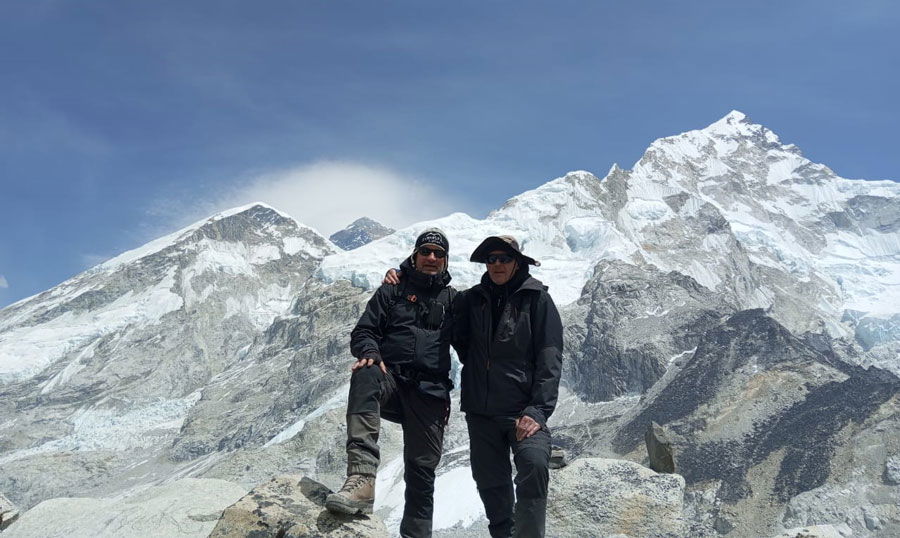Kathmandu to Everest Base Camp Trek: EBC Trek Cost from Kathmandu
Trip Overview
Imagine standing in the shadows of the world’s tallest peak, with prayer flags fluttering in the cold breeze and the Himalayas stretching endlessly around you. That’s the Kathmandu to Everest Base Camp trek—not just a hike, but a soul-stirring adventure. Whether you’re an aspiring trekker or just someone looking to understand what the fuss is about, this guide will walk you through everything you need to know, from bustling Kathmandu to the majestic Everest Base Camp.
Introduction to the Everest Base Camp Trek
The Everest Base Camp (EBC) trek is one of the most iconic journeys in the world. It’s not just about reaching the base of the world’s tallest mountain; it’s about the scenic route, cultural immersion, and personal achievement. Starting from Kathmandu, this trek takes you deep into the heart of the Himalayas through breathtaking landscapes and traditional Sherpa villages.
How to Get from Kathmandu to Lukla
Your journey begins in Kathmandu. From there, most trekkers catch a short flight to Lukla, which is considered one of the world’s most thrilling airports. This 30-minute flight saves days of walking and gives you a stunning aerial view of the mountains. Pro tip: Try to book morning flights — weather is more stable early in the day.
Trek Duration and Ideal Time to Go
How long is the trek? Most standard itineraries range from 12 to 15 days, including acclimatization days.
Best seasons to go?
Spring (March to May): Clear skies, blooming rhododendrons.
Autumn (September to November): Stable weather, great visibility.
Avoid monsoon (June to August) due to heavy rain and winter (December to February) unless you’re prepared for snow and freezing temperatures.
Detailed Day-by-Day Itinerary
Here’s a classic 14-day Kathmandu to Everest Base Camp trek itinerary:
Day 1: Fly to Lukla, trek to Phakding (2,610m)
Day 2: Trek to Namche Bazaar (3,440m)
Day 3: Acclimatization in Namche – short hike to Everest View Hotel
Day 4: Trek to Tengboche (3,860m) – home to a famous monastery
Day 5: Trek to Dingboche (4,410m)
Day 6: Acclimatization in Dingboche – hike to Nagarjun Hill
Day 7: Trek to Lobuche (4,940m)
Day 8: Trek to Gorakshep, visit Everest Base Camp (5,364m)
Day 9: Hike to Kala Patthar (5,545m) for sunrise view, descend to Pheriche
Day 10: Trek to Namche Bazaar
Day 11: Trek to Lukla
Day 12: Fly back to Kathmandu
Day 13–14: Buffer days in case of flight delays (common in Lukla)
This plan ensures proper acclimatization and maximizes your chance of completing the trek safely.
Acclimatization: Why It Matters
Acclimatization is your body’s way of adjusting to high altitudes. The higher you go, the thinner the air — like turning down the oxygen dial on a scuba tank. Skipping acclimatization days can lead to altitude sickness, which can be dangerous or even fatal.
Tips:
“Climb high, sleep low.”
Stay hydrated.
Avoid alcohol and smoking during the trek.
Permits and Entry Requirements
To trek to Everest Base Camp, you’ll need:
Sagarmatha National Park Permit: ~$30 USD
Khumbu Pasang Lhamu Rural Municipality Permit: ~$20 USD
TIMS card is no longer mandatory for EBC (as of recent changes)
You can get these in Kathmandu or Monjo (just after Lukla).
Accommodation and Meals Along the Trek
You’ll stay in tea houses — simple lodges with basic rooms (usually twin beds). Don’t expect luxury, but do expect warm smiles and hearty food.
Meals typically include:
Dal Bhat (lentils, rice, vegetables) – unlimited refills!
Noodles, pasta, pancakes, fried rice
Tea, coffee, and occasional yak cheese
Tip: Food gets more expensive as you go higher due to the difficulty of transporting goods.
Guide vs. Independent Trekking
With a guide:
Safer, especially if you’re a first-timer
Cultural insights and navigation help
Can handle permits and bookings
Solo (independent) trekking:
Cheaper
More flexibility
But requires solid preparation and caution
As of recent updates, trekking solo in some parts of Nepal is discouraged or restricted, so check current rules before planning.
Everest Base Camp Trek Cost from Kathmandu
Let’s talk money. Here’s a general cost estimate for a 12–14 day trek from Kathmandu to Everest Base Camp:
Item Estimated Cost (USD)
Round-trip flight (Kathmandu–Lukla) $450
Permits $50
Guide $30–$35/day
Porter (optional) $20–$25/day
Accommodation (tea houses) $10–$15/night
Meals and drinks $20–$40/day
Gear rental/purchase $100–$300
Travel insurance $100–$150
Misc (Wi-Fi, hot shower, charging) $30–$50
Total estimated cost: $1,200–$2,000, depending on your choices.
Gear and Packing List
Imagine packing for a two-week camping trip — but with mountains, wind, and snow. Here’s what you need:
Essential gear:
Trekking boots (broken in)
Thermal layers and down jacket
Waterproof jacket and pants
Backpack (30–40L)
Sleeping bag (rated to -10°C)
Trekking poles
Headlamp
Water purifier/tablets
Don’t forget:
Sunglasses, sunscreen, lip balm
First aid kit
Power bank
You can rent or buy almost everything in Kathmandu’s Thamel area.
Physical Preparation and Fitness Tips
The trek isn’t technical, but it’s physically demanding. You’ll be walking 5–7 hours daily, often uphill. Start training 2–3 months in advance.
Training tips:
Go for long hikes with a loaded backpack
Strengthen your legs and core
Do cardio (cycling, running, stairs)
Practice walking on uneven terrain
Travel Insurance and Safety
Always get travel insurance that covers high-altitude trekking (up to 6,000m). It should include helicopter evacuation, which can cost thousands without coverage.
Stay safe by:
Listening to your guide
Reporting any symptoms of altitude sickness
Not rushing your pace
Cultural Tips and Etiquette
You’re walking through sacred lands and homes of the Sherpa people. A little respect goes a long way.
Do’s:
Greet locals with “Namaste”
Walk clockwise around mani stones and stupas
Dress modestly
Don’ts:
Don’t touch people’s heads
Don’t point your feet at shrines
Don’t litter — leave only footprints
How to Save Money Without Sacrificing Experience
Travel off-season: Fewer crowds, cheaper stays (but be ready for colder weather)
Share guide/porter costs with a group
Bring snacks from Kathmandu — energy bars are pricey on the trail
Rent gear instead of buying everything new
Filter your own water instead of buying plastic bottles
Final Thoughts and Must-Know Advice
The Kathmandu to Everest Base Camp trek can look overwhelming at first, but with the right planning, it’s 100% achievable. It’s not just a trek — it’s a pilgrimage into the heart of nature and the human spirit. You’ll come back with more than photos; you’ll carry memories that stay with you forever.
So lace up those boots, take a deep breath, and step into the Himalayas — one step at a time.
FAQs
1. Is it possible to trek to Everest Base Camp without a guide?
Yes, it’s possible, but not always recommended. A guide adds safety, cultural value, and handles logistics. Check current rules, as solo trekking has some restrictions.
2. How much money should I budget for the entire trek?
On average, budget between $1,000 and $2,000 USD including flights, permits, food, lodging, gear, and optional guide/porter.
3. What is the highest point on the trek?
Kala Patthar (5,545m) is the highest point, offering the best panoramic views of Mount Everest.
4. What happens if there are flight delays in Lukla?
Weather delays are common. Always add 1–2 buffer days in your itinerary. Helicopter options are available but expensive.
5. Can beginners do the Everest Base Camp trek?
Absolutely! With some physical preparation and acclimatization days, beginners can successfully complete the trek.






